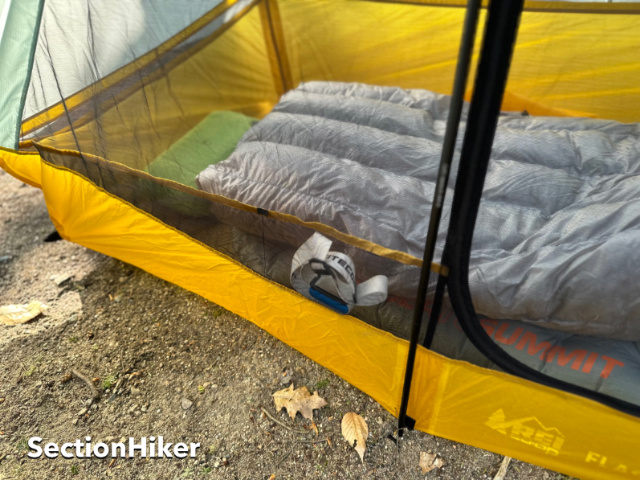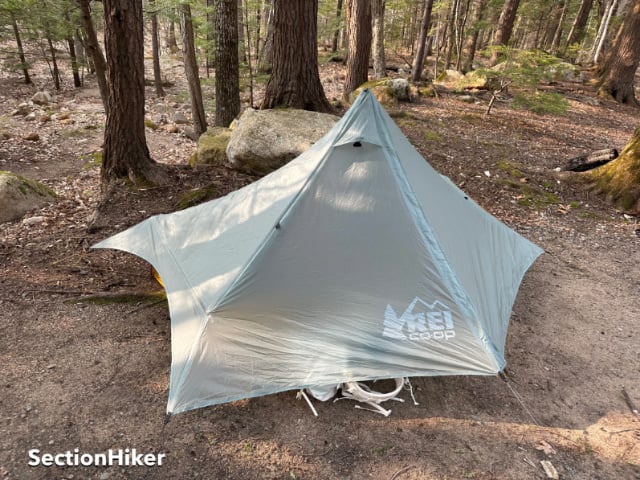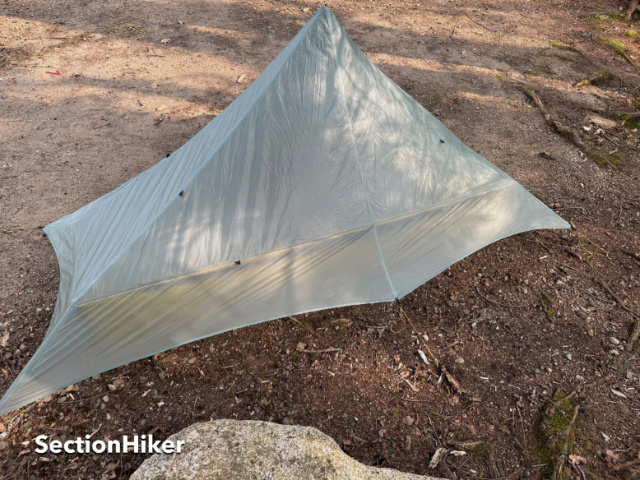The REI Flash Air 1 Tent (new in 2023) is a single-wall ultralight pyramid-shaped tent with a deep bathtub floor and a large front vestibule. Weighing 27.2 oz / g, it’s an affordable ($299) ultralight trekking pole tent (optional pole included) designed for backpacking that’s quite livable, spacious – even for tall people, and wind worthy. The setup is very straightforward since the vestibule and inner tent are joined together, the tent has excellent ventilation and is well appointed with line loc tensioners in the corners to get a taut pitch.
REI completely botched the Flash Air 1 product description on its website, apparently cutting and pasting the descriptions of multiple tents together, so I hope you’ll find this review clarifying. I honestly think the Flash Air 1 is a pretty nifty shelter and I really like the fact that it’s competitively priced so that people without a trust fund can afford it. Ultralight backpacking was never meant to be expensive and elitist and I’m appalled that it’s become just that.
Specs at a glance
- Size: 1 person
- Type: Single-wall
- Structural: Trekking Pole Tent (optional pole included)
- Actual Minimum Trail Weight: 1 lb 11.2 oz (optional pole adds 2.3 oz more)
- Minimum number of stakes to pitch: 6
- Doors: 1
- Actual Bathtub Floor Dimensions: 85″ x 35/27″ (L x W head/foot) inches
- Vestibule Volume: 8.4 sq ft
- Peak Height:42 inches
- Seam-taped: Yes
- Fabric: 20D ripstop nylon
- Hydrostatic head: NA

The REI Flash Air 1 has a pyramid-shaped rainfly and a rectangular-shaped bathtub floor (although the head end is wider than the foot end). The two are connected internally by narrow mesh panels, although the rainfly extends out past the bathtub floor walls creating extra awnings that are deeply curved (called catenary curves) to improve wind worthiness and save weight.

I’ve tested this tent in 30 mph wind and while I did add a few extra guylines to maintain the rain fly volume, it did remarkably well. The rain fly could use a few more gear loops for extra guylines on its more expansive rear panels and seams which catch the wind, but their absence is by no means a showstopper.
The tent comes with an optional center pole (2.3 oz) measuring 47″ (119.4 cm) which can be replaced with a trekking pole. The handle of a trekking pole fits into the reinforced peak, while the sharp end fits into a grommet at the front midpoint of the bathtub floor. It’s a very secure and structurally strong setup. If you opt to use the included center pole (colored black), it has 4 shock-corded segments, with a maximum segment length of 12″.

The internal bathtub floor requires a little more explanation. It is wider at the head and narrows at the foot, but with these dimensions: 85″ x 35/27″ (we carry a tape measure to make our own measurements), it’s wide enough and long enough to hold a wide sleeping pad or a tall person with plenty of extra floor space for internal gear storage.

The back wall of the internal bathtub floor is taller than the front wall, to block cold wind and dust from blowing under the extended awnings. The corners of the back wall are augmented with 16″ aluminum poles to create distinct corners and keep the back from collapsing. The design of these corners is reminiscent of the “pitch-locs” that the company Tarptent uses on many of their tents for the same purpose. There’s no need to remove these 16″ poles from the tent corners when packing the tent (although you can) and I’d recommend leaving them alone.
These corner aluminum poles have another benefit, which is they increase the distance between your face and the rain fly. This is often an issue with steeply angled pyramid-shaped tents and tarps (often called “mids” – short for pyramids) where the fly passes just a few inches above your face and the tops of your toes. These corner struts address this issue by creating more volume and distance between you and the rain fly.

It’s worth mentioning that the 16″ pole length of the corner struts won’t fit horizontally in some backpacks, which is something to consider if you insist on packing your tent horizontally in your backpack. A maximum corner pole segment length of 12″ or 13″ would have made the Flash Air 1 more compatible with a larger number of backpacks, particularly ultralight backpacks, where pack width tends to be narrower.

When you zipper the front vestibule closed, it creates a very large storage space in front of the tent, for any gear you don’t want to bring inside. It’s a one-way zipper, so you can’t leave the top open like a transom for more airflow, but there is a peak vent with a kickstand to help release moisture, particularly from your breath, or if you bring wet gear inside with you.

If you want, you can open the left or right side of the vestibule and there are tiebacks on either side to secure them. My advice is to tie one of the extra reflective guylines that come with the tent to the loop at the apex of the rainfly, so you can roll back both sides of the door and have one side of the tent completely open, with just the front mesh for insect protection. This is my favorite fair weather configuration.
For extra credit, you might also want to add a Zpacks double hook apparatus to the doors, which lets you use one guyline attached to the apex, to roll back the left vestibule door, the right one, or both at the same time without having to re-stake the doors separately.

A few more details:
- The rainfly has quite a few extra guy out loops sewn into the seams, but none on the larger panels. Those would be handy in high wind to help maintain the interior volume.
- When setting up the tent, the corners of the bathtub floor have fixed-length lines, while the corners of the rainfly have line loc tensioners. You can use one stake for both lines, but some re-staking may be necessary.
- The head end of the mesh has two side pockets sized to hold electronics or personal items.
Recommendation
The REI Flash Air 1 is an ultralight trekking pole tent that weighs 27.2 oz and is made with more conventional materials (ripstop nylon) to keep its price reasonable. The interior of the tent is quite large, with plenty of space above the head and toes and along the sides. It has a giant vestibule for gear storage and excellent ventilation for a single-wall tent if you can keep the vestibule partially open. The tent sets up fast because the rainfly and bathtub floor are all one piece so you can do it in the rain without getting the interior drenched.
There really aren’t that many competitive tents to the Flash Air 1, if you only consider single-wall tents, made with more conventional materials, and not Dyneema DCF:
- The Six Moon Designs Lunar Solo (26 oz) is its closest competitor. Made with low-stretch siliconized polyester, it’s also a single-pole, single-wall tent with good ventilation, but has somewhat less weather protection because its floor isn’t as deep. $260.
- The Gossamer Gear “The One” (17.7 oz) is a spacious single-wall tent with a two-pole design. Made with Sil/PU coated fabric, it also has less room above the head and foot ends compared to the Flash Air 1. $299.25
- The Durston Gear X-Mid 1 (28 oz) is a double-wall tent requiring 2 tent poles to set up that is made with low-stretch siliconized polyester. While it also has plenty of non-screened storage space, the interior is comparatively cramped. $240.
Disclosure: REI donated a tent for review.
SectionHiker is reader-supported. We only make money if you purchase a product through our affiliate links. Help us continue to test and write unsponsored and independent gear reviews, beginner FAQs, and free hiking guides.
